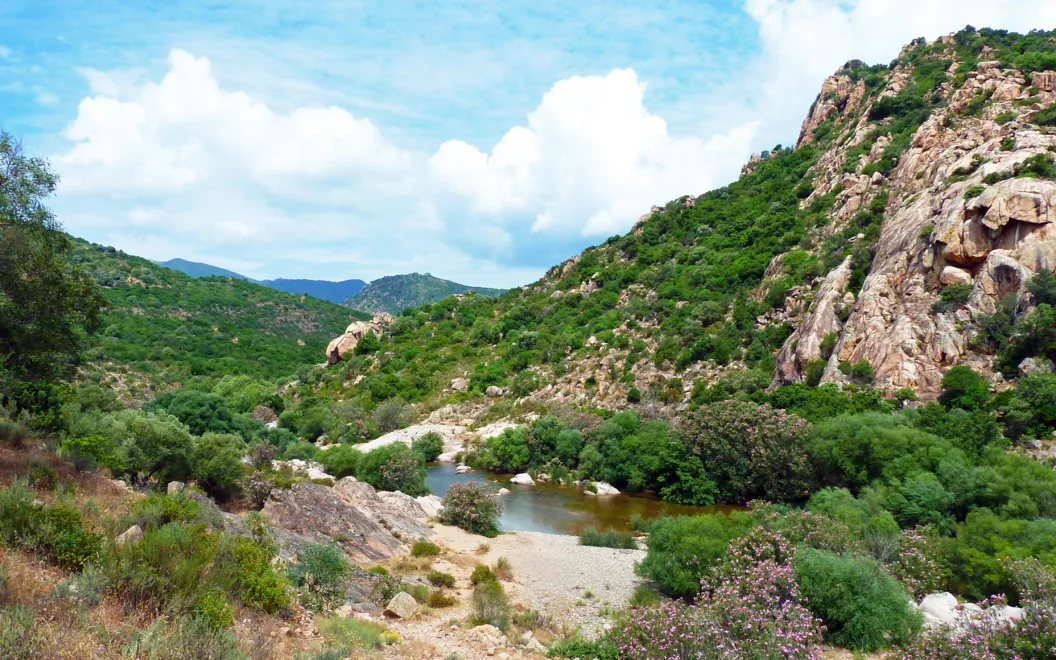Muravera

On the edge of the Flumendosa alluvial plain, Muravera is a town that in the 1970s experienced building expansion along the coast with the birth of villages with a tourist vocation, thanks to the beaches and the sea that, as is often the case in Sardinia, are veritable paradises. For example, to the south are the beaches of S. Giovanni and Torre Salinas, in a beautiful and uncrowded stretch of coastline, or those of Colostrai and Feraxi, which have behind them the ponds of the same name, habitats of various bird species and, in that of Colostrai, a colony of flamingos. In the village, the museum Mif-Museum of Female Entrepreneurship includes theFrancesca Sanna Sulis Museum of Women, visionary designer and entrepreneur who, in an 18th-century Muravera, supported female empowerment, and the Candelai Museum, an ethnographic exhibition, housed in an 18th-century courthouse, devoted to the traditional production of candles begun by the artisan zia Savina, but also to many other local craft activities. But Muravera is also a land of agriculture, known for its citrus fruits, in particular oranges, to which a yearly festival of folklore is dedicated.
Just north of Muravera, there is Villaputzu, where textile manufacturing is still one of the main activities, and its beaches at Porto Corallo and Porto Su Tramatzu. Heading inland, you reach the former Monte Narba silver mine. Along the route there are large areas of forest and some domus de janas, the pre-Nuragic tombs carved into the rock. Returning to the Flumendosa plain, there is San Vito, another centre known for its textile craftsmanship and the musical tradition of the launeddas, at the edge of which is the small church of S. Lussorio. Continuing on, 2 km from Villasalto you will come across the Su Suergiu mine with attached museum.
Armungia

Continuing along the Flumendosa road, we soon reach Armungia, a tiny village gathered around the single-tower nuraghi of the same name dating back to the 15th-14th centuries BC, which is part of the Armungia museum system. It also includes the Sa Domus de is Ainas Ethnographic Museum (house of work tools), with a collection of tools from domestic, peasant, pastoral or hunting work, the Blacksmith's Workshop, set up in a 19th century building, and the Emilio and Joyce Lussu Historical Museum, dedicated to the Armungia-born writer and political activist (1890-1975) and his wife, partisan and writer.
Ballao

Moving northwards, you will soon reach Ballao. The village lies in a wide bend of the Flumendosa river, surrounded by a fascinating landscape: rocks of unusual shapes, natural pools, where you can see, with a bit of luck, grey herons, pheasants, mallards. Nearby, the Corti Rosas mine , part of the Sardinian Geomining Park , where antimony was once mined, now stands as a fine example of industrial archaeology. Evidence of the presence of the Nuragic civilisation are the well temples of Villa Clara and that of Funtana Cuberta, three kilometres north of Ballao. A number of churches scattered around the countryside date back to the Byzantine period, such as those at S. Croce, S. Pietro, S. Rocco and S. Maria Nuraxi. To the south are the ruins of the Castle of Sassai or Orguglioso, built in the 13th century.
Pranu Muttedu Archaeological Park

A kind of Sardinian Stonehenge. Pranu Muttedu, one of the most important prehistoric sites in the region, was a sacred area, part of which was used for ancestor worship, as shown by the presence of monumental tombs, and part dedicated to rituals and other ceremonies. The archaeological park occupies an area of about 200,000 square metres covered with cork oak and Mediterranean scrub, in which some 60 menhirs stand in pairs, aligned or in groups, often arranged in front of tombs, sometimes inside. There are also domus de janas, tombs carved into the rock and elaborately worked. The most distinctive tombs, built of local sandstone, consist of two or three concentric rings of stones and have the burial chamber in the centre. The most remarkable is the so-called Tomb II, with elements typical of both domus de janas and circle tombs. Excavations in the early 1980s unearthed finds from the Ozieri culture (3200-2800 BC) testifying to the presence in the area in the Neolithic and Eneolithic periods.
Dolianova

The last stop on this itinerary in the Gerrei is Dolianova. Founded in 1905 from the merger of two ancient villages, Sicci San Biagio and San Pantaleo, its two patron saints, the town is Sardinia's largest oil and wine production centre. It is easy to see how widespread both olive growing and wine production are, because around the settlement there are expanses of vineyards and neat rows of olive trees. Il Sa mola Museum of Oil celebrates and describes the oil, cultivation and production techniques. The real attraction of Dolianova, however, is the church of S. Pantaleo, unique in the sardinian romanesque panorama. It was built between the beginning of the 12th century and 1289 in sandstone, and features a few Gothic elements from the last renovation. The façade and bell tower are decorated with pilasters and arches, and punctuated by geometric decorations and mythological motifs. With its three naves, the interior is impressive, with walls featuring large arches supported by columns with Romanesque capitals, carved with scenes from the New Testament, and Gothic capitals, decorated with crochet leaves. Also striking are the frescoes, the sculptural decoration and the pictorial works such as the Altarpiece of San Pantaleo, from the end of the 15th century.





